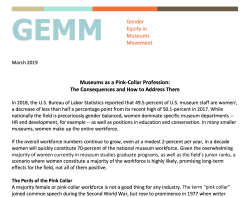The Museum Workplace & Standing Up for What’s Right
Posted: October 9, 2017 Filed under: Uncategorized 1 Comment
There’s been a lot of attention paid to courageous museums and their leaders lately. Witness Puerto Rico where the Art Museum decided to open a week after the hurricane. Their idea? That despite the devastation around them, the museum was a place of safety, renewal, and happiness. Or how about Eastern State Penitentiary’s exhibit Prison’s Today, which knew it was tackling a volatile subject, and rather than ignore the elephant in the room, decided it would take a point of view, advocating from the opening panel that “Mass Incarceration Isn’t Working.” Or, curators like Rainy Tisdale after the Boston Marathon Bombing or Aaron Bryant at the African American History Museum who refuse to wait for history to “get old,” but document it as it happens? Or most recently the Queens Museum’s Director Laura Raicovich’s stance on the Deferred Action for Childhood Arrivals.
While these individuals and organizations deserve our deepest respect and thanks, we need to talk about another aspect of courage. We need to talk about courage in the museum workplace as opposed to the museum itself. We need to talk about courage “backstage” as opposed to “on-stage.” Because decisions like the ones listed above affect an organization’s brand, donor base, and gate, they are rarely made alone. Instead there is a calculus involved, measuring mission and vision versus damaging PR, institutional values versus organizational gain. That doesn’t diminish the courage of these decisions, but they aren’t the same as those made in the museum workplace. There, it’s all about individuals. And it’s also about fearlessness.
This week we read a piece published on Incluseum called “LETTER TO YOUNG MUSEUM PROFESSIONALS OF COLOR OR WHAT TRANSPIRES ON A LONG-HAUL CAREER WHEN CONFRONTED WITH RACISM IN THE MUSEUM,” by longtime museum consultant, Radiah Harper. If you haven’t read it, you should. Appearing less than a week after Alliance Lab’s piece on attrition from the field, Harper’s letter opens with the lines:
You know when someone or something has crossed the threshold of your sanity in the workplace. At that moment, you have to make decisions, even when in a senior position. Has there been an irrevocable offense? Is it racism or oppression and intolerable? We ask ourselves, can I afford to quit?
I believe that most of us think that museum work is about doing good. We teach, we preserve, we research, we enlighten, we spark imagination, we provide beautiful spaces where families and friends gather. I suspect, when asked about our work, we think more about that public good then we do about our workplaces. And yet ours is a field where every day someone experiences racism or bias, gender stereotyping or sexual harassment.
Is it possible we spend way too much Facebook time decrying Charlottesville and whether or not monuments to the Confederacy should stay or go, and not enough thinking about what it’s like to be non-white in a museum workplace? Do most museum employees even know that one in three American women is sexually harassed at work? Do they understand that museums and heritage organizations aren’t exempt from sexual harassment? And what about employees who deal with multiple layers of bias and prejudice –women of color, lesbian or queer women, transgender women.
This is where we need personal courage. We need courage to stand beside and stand up for our colleagues; to interject when someone says something racist, unkind and biased. And if, for whatever reason,we are among the museum workers who are privileged, we need to use that privilege to make changes in workplace behavior. Maybe our small acts of conscience will change the museum field for the better.
Stop talking. Just act.
Joan Baldwin










Amen. And, thanks.